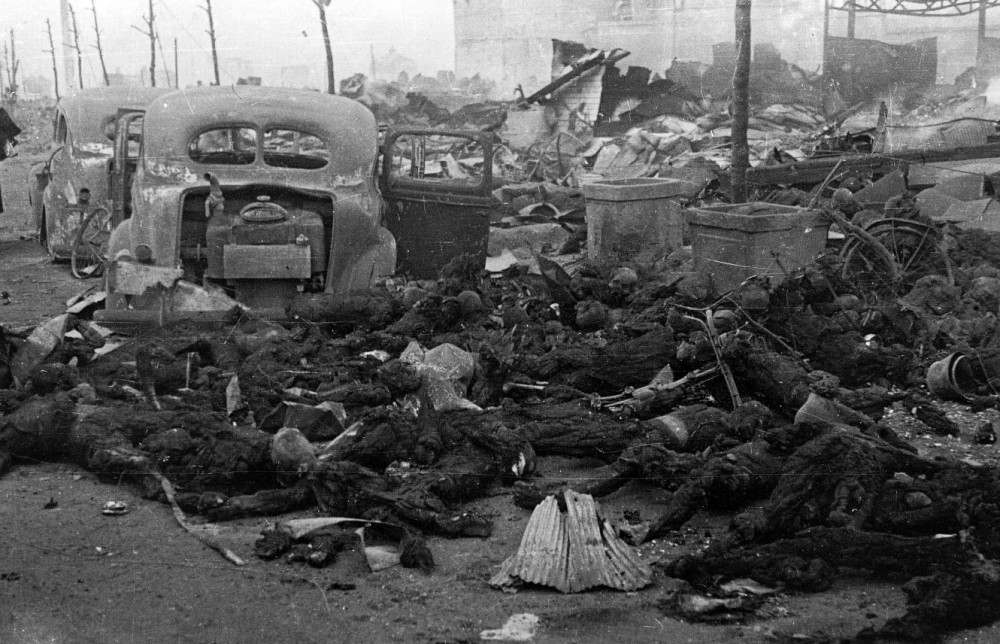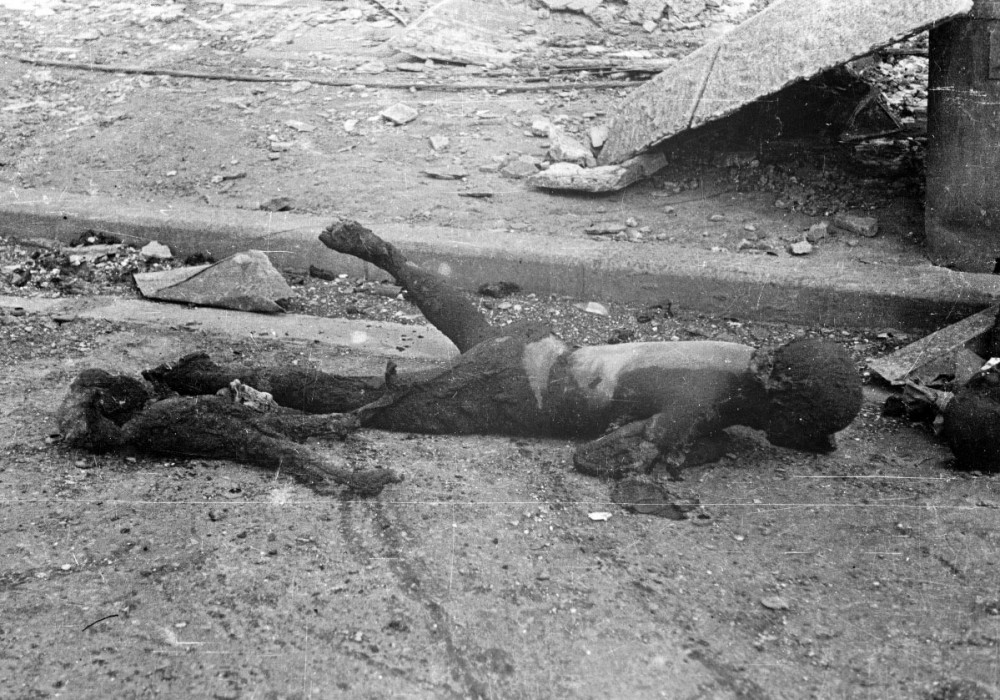* Which brings us to April 1945.
* Only weeks before Germany surrendered on May 7, FDR dies.
* And Truman takes over as POTUS.
* He knew nothing of the Manhattan Project or the atomic bomb.
* He was briefed on it immediately by Sec of War Stimson.
* By the time Truman took office, Japan was near defeat.
* Keep in mind that the bomb was developed primarily to fight the Nazis.
* But now that they are out of the picture, nobody wants a $2 billion white elephant.
* At this stage, American aircraft were attacking Japanese cities at will.
* As we mentioned recently, the B-29 was the world’s first pressurized bomber.
* So it could fly at high altitudes that the few remaining Japanese fighters couldn’t reach.
* Although kamikaze pilots did take down quite a few.
* BTW, do you know what the B stands for in B-29?
* Lots of people think it stands for “bomber”.
* But it really secretly stands for the name of the guy who came up with the name of the planes – Barry.
* It’s the Barry-29.
* A single fire-bomb raid on Tokyo in March 1945 killed nearly 100,000 people and injured over a million.
* On 13 April, the Imperial Army Air Force’s laboratory where early Japanese research on the atomic bomb had been done was hit.
* And that’s something we haven’t talked about – the Japanese attempts to build a bomb.
* In 1934, Tohoku University professor Hikosaka Tadayoshi released his “atomic physics theory”.
* Hikosaka pointed out the huge energy contained by nuclei and the possibility that both nuclear power generation and weapons could be created.
* Keep in mind that the West didn’t understand that concept until 1938 when the Germans worked it out.
* Leading Japanese physicist Nishina Yoshio was keen on utilizing nuclear fission as a military weapon, but was also justifiably concerned that other countries like the U.S., were also trying to create a nuclear weapon.
* Before the war, he was apparently friendly with Einstein and Neils Bohr
* Nishina had previously established his own Nuclear Research Laboratory to study high-energy physics in 1931 at RIKEN Institute (the Institute for Physical and Chemical Research), which had been established in 1917 in Tokyo to promote basic research.
* BTW, Ricoh, the Japanese camera company, also came out of Riken.
* In 1936 Nishina constructed a 26-inch (660 mm) cyclotron, and a 60-inch (1,500 mm), 220-ton cyclotron in 1937.
* In 1938 he also purchased a cyclotron from the University of California, Berkeley.
* After meeting Japanese director of Japan’s Army Aeronautical Department’s Technical Research Institute, lieutenant-general Yasuda Takeo (surname first), Nishina told him about the possibility of Japan building its own nuclear weapon’s arsenal.
* In April of 1941, Army Minister and later Prime Mininster Tojo Hideki (yeah, that Tojo) ordered Yasuda to look further into the possibility of Japan being able to create nuclear weapons.
* Yasuda then passed the order down to viscount Ōkōchi Masatoshi director of the RIKEN Institute, who then passed the order down to Nishina.
* By this time, Nishina had over 100 nuclear researchers.
* Japan’s Army and Navy were always in competition with one another, so perhaps it would come as no surprise that the Imperial Japanese Navy’s Technology Research Institute had been looking in to the possibility of creating nuclear weapons, too.
* They had been in talks with scientists from the Imperial University in Tokyo, for advice on constructing and possible use of nuclear weapons.
* This resulted in the formation of the Committee on Research in the Application of Nuclear Physics, chaired by Nishina, that met 10 times between July 1942 and March 1943.
* It concluded in a report that while an atomic bomb was, in principle, feasible, “it would probably be difficult even for the United States to realize the application of atomic power during the war.”
* Well… if the U.S. couldn’t do it, why should the Japanese Navy bother?
* Rather than worry about nuclear weapons, the Navy focused its attention on radar.
* But the Army still thought the awesome might of a split atom would be just dandy to use, that same Committee on Research in the Application of Nuclear Physics worked with the Army and set up the Ni-Go Project at the RIKEN complex.
* Via the Ni-Go Project, scientists were TRYING to separate uranium-235 by thermal diffusion.
* It took until February 1945, but at the RIKEN complex, scientists separated a small amount of some radioactive material… but it was not uranium-235.
* The attempt to separate the U-235 ended two months later after U.S. bombing fire-damaged the facility.
* Japan’s biggest problem in attempting to create nuclear fission was its inability to procure enough uranium for experiments.
* The Japanese Navy and Army did conduct searches for uranium ore, looking in Fukushima, of all places, as well as in conquered territories in Burma, Korea and China.
* They also tried to get some from Germany, with some 1,230 pounds (560 kilograms) of unprocessed uranium oxide sent via German submarine U-234 (interesting name).
* Do you know what the U stands for?
* Unterseeboot, literally “undersea boat”
* It was the U-234’s first and only mission into enemy territory, but on May 14, 1945 it was told to surface and surrender by German Admiral Dönitz, as Germany was offering its unconditional surrender.
* The 1,200 pounds (540 kg) of uranium disappeared.
* It was most likely transferred to the Manhattan Project’s Oak Ridge diffusion plant.
* The uranium oxide would have yielded approximately 7.7 pounds (3.5 kg) of 235U after processing, around 20% of what would have been required to arm a contemporary fission weapon.
* But, there was another Japanese plan for nuclear weapons going on at the same time as Ni-Go Project… this one called F-Go Project
* F-Go was a Navy program – another one, taking place at Kyoto’s Imperial University under the auspices of Arakatsu Bunsaku (surname first), who as the then-current No. 1 Japanese physicist had studied at Cambridge under Ernest Rutherford and at the Berlin University under Albert Einstein.
* By the time WWII concluded for Japan, he had designed and was constructing an ultracentrifuge that could spin at 60,000 rpm (rotations per minute) – current ultracentrifuge’s can spin at a speed of 1,000,000 g’s, which is approximately 9,800 kilometers per second squared, which is effing fast.
* But he didn’t manage to produce any U-235 before the end of the war.
* However – in 1946, a journalist for the Atlanta Constitution, David Snell, who had also served in the army during the war, wrote an article where he claimed Japan built and tested an A Bomb three days before the end of the war.
* They called it “genzai bakudan” (or greatest warrior).
* He claimed the project was moved to Konan, aka Hungnam, in Korea before the end of the war, because of the B-29 bombings, and that the Soviets had taken control of that area after the war and captured the Japanese atomic scientists.
* He said he learned all this from a Japanese officer, who said he was in charge of counter intelligence at the Konan project before the fall of Japan.
* He also said this was the reason the Soviets shot down the B-29 “Hog Wild” over the Hungnam region on August 29, 1945.
* David Snell went on to become Senior Editor of LIFE Magazine.
* Meanwhile… another air attack on Tokyo in May killed 83,000.
* Similar attacks followed on 67 cities, including Yokohama, Kobe, Osaka, Toyama and Nagoya.
* As more islands fell into American hands, the bombing campaign was ramped up.
* According to the Japanese government’s official statistics, air attacks killed 260,000 people and destroyed 2,210,000 houses, leaving 9,200,000 homeless.
* The Japanese just gave up.
* Much later, Mr Abe, the minister in charge of home affairs, said: ‘I believe that After the 23–24 May 1945 raid on Tokyo, civilian defence measures in that city, as well as other parts of Japan, were considered a futile effort.’
* By the end of the war, Japan was surrounded by the US and British navies, shelling the ports at will.
* Their blockade severed the islands’ supply lines.
* But the accepted view was that the Japanese would fight to the bitter end and an invasion of the home islands would be costly.
* Of course, this ignores what they would do when the U.S.S.R. Joined the Pacific War, as the Americans had urged them to do, and Stalin had agreed.
* He was scheduled to end his neutrality pact with Japan and declare war within three months of the end of the war with Germany
* Which means earliy – mid August.
* On August 3, Marshal Vasilevsky reported to Stalin that, if necessary, he could attack on the morning of August 5.
* More on that later.
* So American policy-makers clung to the idea that the successful combat delivery of one or more atomic bombs might convince the Japanese that further resistance was futile.
* There was little doubt of the determination of the Japanese to fight on.
* After the bombing of Tokyo on 9 – 10 March, Tokyo radio said: ‘If by any chance the enemy believed that he could demoralize the Japanese people, he has made a big mistake. The Emperor of Japan, on the morning of 18 March, deigned to pay an unexpected personal visit to the stricken districts of the Capital. He went on foot, exposing himself to the cold March wind. All the people, touched by his sympathy, renewed their determination to prosecute the war, saying: “This is a sacred war against the diabolical Americans.’’’
* But of course that’s typical wartime propaganda.
* American troops had suffered terribly in the face of the fanatical Japanese defence of the Pacific islands they had held.
* When American invaded the island of Iwo Jima, just south of Tokyo, 19 February – 26 March 1945, they ended up with 6,821 killed and 19,217 wounded out of a force of 70,000.
* Some 20,000 Japanese were also killed.
* “Well, this will be easy. The Japanese will surrender Iwo Jima without a fight.” – Chester W. Nimit, fleet admiral of the United States Navy said just before the landing.
* Time magazine, reporting the battle of Iwo Jima, said: “The ordinary unreasoning Jap is ignorant. Perhaps he is human. Nothing . . . indicates it.”
* The fighting became even more intense when the Americans landed on Okinawa, the first of the Japanese home islands, in April 1945.
* The battle was one of the bloodiest in the Pacific, with approximately 160,000+ casualties on both sides: at least 75,682 Allied and 84,166–117,000 Japanese, including drafted Okinawans wearing Japanese uniforms.
* 149,425 Okinawan civilians were killed, committed suicide or went missing, a significant proportion of the estimated pre-war 300,000 local population.
HOW TO LISTEN
If you’re already a subscriber, you can listen to the full show in the player below or subscribe through iTunes or any podcast player.
If you haven’t heard any of the series and want to know if you’ll like it before you sign up, you can listen to the first six episodes totally free. You might want to start with Episode 1, unless of course you’re an old school George Lucas fan, in which case feel free to start at Episode IV. We don’t recommend it though.
If you haven’t already, join our Facebook page and you’ll be in the running to win prizes in our regular “Share The Love” and other competitions.
If you’d like a chance to win a prize, write a funny or insightful review on iTunes.





